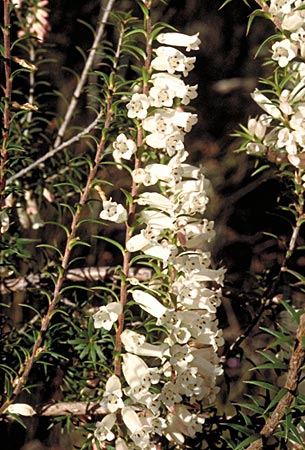General Description:
The plant family Ericaceae (heaths and heathers) is widespread in many parts of the globe, particularly Europe and South Africa. It contains a number of widely cultivated plants such as Erica, Rhododendron and Pieris.
Like most of Australia’s members of the Ericaceae, Epacris belongs to the subfamily Epacridoideae, which was formerly classified as a separate family, the Epacridaceae. Epacris consists of about 40 species of mainly small shrubs. Most are endemic to Australia but a few species can be found in New Zealand and New Caledonia. They occur in a variety of habitats from alpine areas to coastal heaths.
The deep pink form of E.impressa is the floral emblem of Victoria. This is usually a small shrub of less than a metre in height but it can reach 2-3 metres in some locations. The branches are stiff and have small leaves with a sharp point at the end. The flowers are narrow and tubular, about 20mm long and occur in clusters among the ends of the branches. They contain nectar and are frequented by honey-eating birds. The colour ranges from white through various shades of pink to bright red. Flowering occurs from autumn through to spring.
A form from the Grampian Ranges in western Victoria is known as E.impressa var.grandiflora. This variety has larger flowers and leaves than the typical form and some plants have “double” flowers.
E.impressa is a widely cultivated species, but is not always successful. The plant occurs over a wide range and forms from dry summer areas may not succeed in humid areas, and vice versa. One of the most adaptable forms seems to be that from the south coast of New South Wales (usually sold as the “Bega” form). This form has bright red flowers.
The species should be given a well drained position in semi shade or full sun. It is also a very attractive plant for a container.
Propagation of E.impressa is usually by cuttings of firm current season’s growth. The species can be grown from seed but this is not readily available.

Pink form of Epacris impressa
Photos: Brian Walters

White form of Epacris impressa
Photos: Brian Walters

‘Bega’ form of Epacris impressa
Photos: Brian Walters
Other Native Plant Profiles
 Australian Native Plants Society (Australia)
Australian Native Plants Society (Australia)













